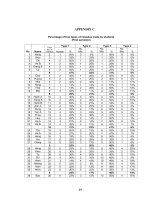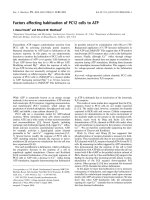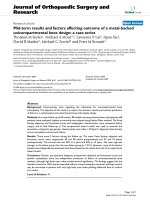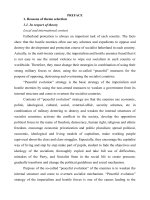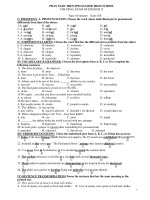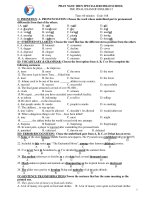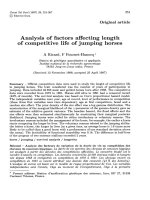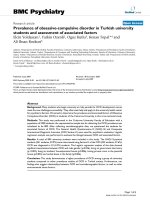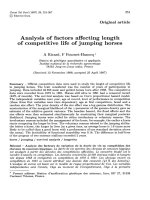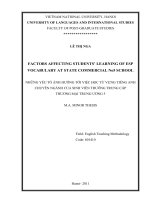Econometrics final exam factors affecting quantity of new cars sold foreign trade university students
Bạn đang xem bản rút gọn của tài liệu. Xem và tải ngay bản đầy đủ của tài liệu tại đây (567.84 KB, 35 trang )
FOREIGN TRADE UNIVERSITY
INTERNATIONAL ECONOMICS FACULTY
…………..o0o…………..
ECONOMETRICS FINAL EXAM
TOPIC: FACTORS AFFECTING QUANTITY OF NEW CARS SOLD
FOREIGN TRADE UNIVERSITY STUDENTS
Class
: K57 JIB
Lecturer
: Ms. Tu Thuy Anh
Ms. Chu Mai Phuong
Group
: 16
Members : Dao Thi Kim Linh - 1815520187
Mai Thanh My Linh - 1815520189
Nguyen Thi Ha Vy - 1815520239
HaNoi – 10/2019
Introduction
The market of car in US remains fiercely competitive from the beginning in
the late 1890s until now. Beginning in the 1970s, a combination of high oil prices
and increased competition from foreign auto manufacturers severely affected the car
companies in US. Therefore, it is necessary to investigate the car industry in the
period of time in 1970s to understand not only the car market but also the market
operation as a whole. In this research we want to investigate the six variables which
seem to have impact on the number of car in US from 1975 to 1990. This result can
contribute to the judgement on the car industry in US. Moreover, it helps to strength
the theory of the relationship between macroeconomic and microeconomic factors
and the quality of product sold.
The research has use the quantitative method and has the following structure:
Part 1: Data description
Part 2: Econometrics model
Part 3: Robustness check
Part 4: Result table
TABLE OF CONTENT
I. Abstract
1
II. Literature Review
III. Methodology
2
5
IV. Theoretical background
6
V. Data description 10
1. Variables table 10
2. Data description 10
3. Correlation matrix
11
VI. Econometrics model 13
1. Population regression function (PRE)
13
2. Sample of regression function (SRF) 13
3. Result
13
4. Meaning of coefficient 14
5. Testing a hypothesis relating to a regression coefficient 15
6. Adjusted regression model
VII. Robustness check
20
1. Multi-collinearity
20
2. Heteroskedasticity
22
3. Normality 23
4. Autocorrelation 24
VIII. Result table 26
IX. Conclusion
28
X. References
29
XI. Appendix
30
18
I. Abstract
This research investigates the relationship between microeconomic,
macroeconomic variables and number of cars sold in US. The main objective is to
determine the factors that affecting the number of car sold in US. This research
covers the time period from 1975 to 1990. The analysis methods that have been
applied in this study include descriptive statistics, linear regression and correlation
analysis. The findings show that price, income have positive relationship with the
number of car sales in US, while the prime interest rate and population have
negative relationship with the number of car sales in US. The income has the most
influence on the quantity of car sold while the population has unreliable effect on it.
However, the gap in impact on number of cars sold among four factors is not huge.
The findings were consistent with the previous findings done by other researcher.
1
II.
Literature Review
There are many researches that investigated the relationship between quantity of
car sold and its determined factors all around the world. Our research focuses on the
relation between number of car sold in US and six variables including Price index,
Prime interest rate, Income, Unemployment rate, Stock, Population. In the research
process, there are some studies which share the same common with objects to our
studies’. We present them here below.
In 2010, Faculty of Mechanical Engineering, Industrial Engineering and
Computer Sciences in School of Engineering and Natural Sciences University of
Iceland performed a study called The Effects of Changes in Prices and Income on
Car and Fuel Demand in Iceland. It examined the elasticities of demand for fuel and
cars in Iceland will be examined, both with a common classical reversible demand
model and also with an irreversible model, in order to examine asymmetric effects
from variables influencing the demands.
It constructed both reversible and reversible models for the demand of new cars
and then used regression analysis on these models. The econometrics results
showed that income has a great impact on the demand for new cars in Iceland.
Increase in income has much more effect on the purchase of new cars than the size
of the car fleet, which means that more new cars come into the fleet and more old
ones go out when income increases. So that the car fleet changes with increasing
income and consists more of newer and better cars that use less energy and are
better for the environment.
In 2012, Education University of Sultan Idris Malaysia did a research on
Automobile Sales and Macroeconomic Variables: A Pooled Mean Group Analysis
for Asean Countries. This paper analysed the impact of economic variables on
automobile sales in five ASEAN countries involving Malaysia, Singapore,
Thailand, Philippines and Thailand collecting annual data from 1996 to 2010. The
long term and short term correlation between these variables are implemented using
the panel error-correction model. Two methods are implemented specifically the
Mean Group (MG) and Pooled Mean Group (PMG). These two methods were
introduced by Pesaran dan Smith (1995) and Pesaran et al. (1999). Result from the
test shows that gross domestic product (GDP), inflation (CPI), unemployment rate
2
(UNEMP) and loan rate (LR) have significant long term correlation with
automobile sales in these ASEAN countries. The GDP variable is found to have
positive relationship with car sales. This proves that national income level is an
important determinant for the automotive industry. In contrast, spikes of inflation,
unemployment rate and interest rate are found to inflict negative impact on car
sales. Besides, each country is influenced by different variables in the short term
period.
In 2013 Joseph Chisasa and Winnie Dlamini from University of South Africa,
South Africa did a research on An Empirical Analysis Of The Interest Rate-Vehicle
Purchase Decision Nexus In South Africa. This paper empirically examines the link
between interest rates and the borrowers’ decision to purchase a passenger vehicle
in South Africa.
They used monthly time series data of passenger vehicles purchased, household
income, fuel prices, prime interest rates and producer price index for manufacturers
from January 1995 to December 2011. With passenger vehicle unit purchases as the
dependent variable, they obtained OLS estimates of the passenger vehicle purchase
function. Results show that there is a negative, but insignificant, relationship
between interest rates and passenger vehicle purchases in South Africa. Holding
other factors constant, a 1% increase in interest rate results in a 0.9% decrease in
passenger vehicle purchases. Household income, fuel price and producer price
index are observed to have a positive and insignificant impact on the decision to
purchase a passenger vehicle.
In 2014, Vaal University of Technology University of KwaZulu did a research
on The Impact of Inflation on the Automobile Sales in South Africa. This paper
analysed the relationship between inflation (INF) and Automobile sales in South
Africa by using the co-integration and causality tests. The analysis has been
conducted using monthly data over the period 1960:1 through 2013:9. The
empirical results show that there is a long-run relationship between new vehicle
sales and inflation over the sample period of 1969 to 2013.
Other factors that have been analysed were income
level, interest rate,
financial aggregate and unemployment rate. These include in the research by
3
Shahabudin (2009) on domestic and foreign cars sales. In this research, it was
discovered that all variables could significantly influence car sales. However, this
regression model suffered from heteroscedasticity that affected the efficiency to
gauge domestic and foreign car sales. In this research, it is proven that all variables
could significantly influence car sales. However, the problem of heteroscedasticity
had impaired the efficiency of the model as a whole.
Dargay (2001) using Family Expenditure Survey from 1970 t0 1995, it was found
out that the statistics of vehicle ownership recorded a positive upward trend with
income increase. However, there is a negative correlation when there is an
income reduction. This is associated with the personal habit of individual
consumers as vehicle is seen as an important necessity in the present context of
everyday life.
All the researches we mentioned above just focused on the effect of one or
some factors of the 6 factors we chose and none of them described the effect of all
the 6 factors on the quantity of new cars sold, especially in the US market.
Considering that there is no specific research conducted to analyse the
relationship between these economic variables in the context of US thus far, we
decided to conduct a study on “Factors affecting quantity of new cars sold in the
US”. We will examine the effect of 6 factors (Price index, Prime interest rate,
Income, Unemployment rate, Stock, Population) on quantity of new cars sold with
the help of regression analysis, and then draw some conclusions through the result.
Our research will focus on the US market.
III.
Methodology
We carry out this research by using 15 years’ time periods from 1975 till
1990 as the sample of analysis. Consequently, time series analyses were used in the
study of car sales in US and each factor throughout 15 years. To analyze the
4
relationship between dependent variables and independent variables in this study,
linear regression will be used.
The software that chosen for analyze and work with these data is the
software Gretl. The data we use in the research is taken from Gretl as well: It is the
data 9.7 in Ramathan category in Gretl.
IV.
Theoretical background
In many countries car is one of the most expensive goods and is considered
as a luxury good. However, in this research we want to examine the number of cars
sold in US generally, which means that car is considered as a normal good. The
5
theory we based on is the theory of principle of microeconomics and
macroeconomics formulated by N. Gregory Mankiw. The detail application of this
theory will be presented in order of the relationship between the dependent variable
and four independent variables in our research.
Price index
A price index (also known as "price indices" or "price indexes") is a
normalized average (typically a weighted average) of price relatives for a given
class of goods or services in a given region, during a given interval of time. It is a
statistic designed to help to compare how these price relatives, taken as a whole,
differ between time periods or geographical locations.
In the research, we will analyze the effect of consumer price index (CPI) on
the quantity of goods sold. The CPI is the measure of overall cost of the goods and
services bought by a typical consumer. It is also a helpful means to measure the
inflation rate.
Because the CPI indicates prices changes—both up and down—for the
average consumer, the index is used as a way to adjust income payments for certain
groups of people. For instance, more than 2 million U.S. workers are covered by
collective bargaining agreements, which tie wages to the CPI. If the CPI goes up, so
do their wages. The CPI also affects many of those on Social Security—47.8
million Social Security beneficiaries receive adjusted increases in income tied to the
CPI. And when their incomes increase, the demand for goods and services also
increases, which raises the quantity of goods sold, in our case is quantity of new
cars sold.
Income
According to the theory of market forces of supply and demand in
microeconomics of Mankiw, income is one of the main factors that shifts the
demand curve, which contributes to the change in the number of product sold.
6
When being considered as a normal good, the income and the price goes in
the same direction, which means an increase in income leads to an increase in
demand. In the model, the demand curve shifts to the right. As a result, when the
demand rises, it raises the quantity of car sold.
Prime interest rate
The prime rate is the interest rate that commercial banks charge their most
creditworthy corporate customers. ese are the businesses and individuals with the
highest credit ratings. They received this rate because they are the least likely to
default. Banks have little risk with these loans The prime interest rate, or prime
lending rate, is largely determined by the federal funds rate, which is the overnight
rate that banks use to lend to one another. Prime forms the basis of or starting point
for most other interest rates—including rates for mortgages, small business loans, or
personal loans—even though prime might not be specifically cited as a component
of the rate ultimately charged.
Banks base most interest rates on prime. That includes adjustable-rate loans,
interest-only mortgages, and credit card rates. Their rates are a little higher than
prime to cover banks' bigger risk of default. They've got to cover their losses for the
loans that never get repaid. The riskiest loans are credit cards. That's why those
rates are so much higher than prime. The prime rate affects household when it rises.
When that happens, the monthly payments increase along with the prime rate.
The prime rate also affects liquidity in the financial markets. A low rate
increases liquidity by making loans less expensive and easier to get. When prime
lending rates are low, businesses expand and so does the economy. Similarly, when
rates are high, liquidity dries up, and the economy slows down.
In sum, the prime rate considered as a factor affecting the quantity of
product sold has the same role and effect as interest rate. It influences the quantity
in two sides: the household which affects the consumption and the firms which
affects the investment or production. According to the theory of aggregate demand
of Mankiw, the interest rate has the power to shift the aggregate demand curve.
7
Changes in interest rates can affect several components of the AD equation.
The most immediate effect is usually on capital investment. When interest rates rise,
the increased cost of borrowing tends to reduce capital investment, and as a result,
total aggregate demand decreases. Conversely, lower rates tend to stimulate capital
investment and increase aggregate demand.
On the household side, lower interest rate encourages them to hold money in
hands. Consumer confidence about the economy and future income prospects also
affect how much consumers are willing to extend themselves in spending and
financing obligations. As a result, it increases the consumption. An increase in
interest rates may lead consumers to increase savings since they can receive higher
rates of return. A corresponding increase in inflation often accompanies a decrease
in interest rates, so consumers may be influenced to spend less if they believe the
purchasing power of their dollars will be eroded by inflation.
Unemployment rate
The unemployment rate is defined as the percentage of unemployed workers
in the total labor force.
One of the main factors influencing demand for consumer goods is the level
of unemployment, which is measured by the unemployment rate. The more people
there are receiving a steady income and expecting to continue receiving one, the
more people there are to make discretionary spending purchases. That also means
when the unemployment rate increases, the demand for a good decreases, which
leads to the decrease in the quantity sold of a product. Therefore, the monthly
unemployment rate report is one economic leading indicator that gives clues to
demand for consumer goods.
Stock
The stock represents for the number of cars on the road. This number of cars
in the time series data shows the trend in consumption of cars. In other words, it
8
tells the demand direction of people. If the number increase time after time, the
demand increases, therefore, the quantity of car sold and the stock go the same
direction. In contrast, when the demand for car decreases, the stock has a negative
impact on number of car sold.
Population
According to Microeconomics knowledge developed by Mankiw, the change
in population will shift the demand curve. As the population increases, the demand
for goods increase because each member of the population has needs to be filled.
That leads to the increase in the quantity of goods sold.
However, these needs changes overtime as the segments of the population
age and their needs and wants change. So that there is nothing sure about the
increase in the quantity of a specific goods sold if the population increase in reallife situation.
V. Data description
1. Variables table
Table 5.1: Variables table
9
Variables
Abbreviation
New car sales
Y
Meaning
Quantity of new cars sold
Unit
1000 units
quarterly
Average real price index of a
Price
$
new car
Per capita disposable
Income
Prime
Unemployment
Stock
Population
personal income
Prime interest rate
Unemployment rate
Number of cars on road
Population
X5
X6
1000$
%
%
1000 units
1000 people
2. Data description
Table 5.2: Summary statistic table ( Source: Gretl)
QNC
Price
Income
Prime
Unemp
Stock
Pop
(Y)
(X1)
(X2)
(X3)
(X4)
(X5)
(X6)
Mean
2488.6
95.213
10.521
10.687
7.0109
109.77
233.77
Median
2495.5
98.250
10.166
10.000
7.1000
107.77
234.04
Minimum
1754.0
60.200
8.9850
6.2500
5.1000
93.145
215.97
Maximum
3337.0
121.40
11.930
20.320
10.500
123.30
251.97
Std.Dev
332.92
18.947
0.84566
3.3994
1.3626
8.9283
10.489
C.V.
0.13378
0.19900
0.080376
0.31809
0.19435
0.081334
0.044870
Skewness
0.18571
-0.31097
0.24957
1.0855
0.60303
0.018833
-0.024827
Ex.kurtosis
-0.22879
-1.1880
-1.0855
0.51036 -0.20593
-1.1244
-1.1555
Description:
Y QNC Mean: The average quantity of new cars sold from data surveyed is
2488.6 x103 units quarterly.
10
Y QNC Median: Fitted value of dependent variable Y QNC is 2495.5x103
units quarterly.
Y QNC Minimum: The minimum quantity of new cars sold among 64
quarters surveyed is 1754.0x103 units.
Y QNC Maximum: The maximum quantity of new cars sold among 64
quarters surveyed is 3337.0x103 units.
Std. Dev. (Standard Deviation): is a measure of how spread the numbers are,
equals to the square root of sample variance. The Std. Dev. of Y QNC here is
332.92.
C.V. (Coefficient of Variation): is simply the standard deviation divided by
the sample mean. Large values of the C.V. indicate that the mean is not very
precisely measured. The C.V. of Y QNC here is 0.13378.
⇒ From the summary statistic table, we can see that it might be the representative
sample for Quantity of new cars sold quarterly(Y) (QNC) depends on the 6
variables which are Price (X1), Income (X2), Prime(X3), Unemployment (X4),
Stock(X5), Population (X6).
3. Correlation matrix
Correlation Coefficients, using the observations 1975:1 - 1990:4
5% critical value (two-tailed) = 0.2461 for n = 64
Table 5.3: Correlation of variables table (Source:Gretl)
QNC
Price
Income
Prime
Unemp
Stock
Pop
(Y)
(X1)
(X2)
(X3)
(X4)
(X5)
(X6)
1.000
0.0164
0.1994
-0.4588
-0.4533
0.1363
0.0441
1.0000
0.9386
0.1285
-0.3553
0.9732
0.9918
1.0000
-0.0485
-0.6137
0.9849
0.9642
11
QNC
(Y)
Price
(X1)
Income
(X2)
1.0000
0.1779
0.0050
0.0560
1.0000
-0.5354
-0.4206
1.0000
0.9864
Prime
(X3)
Unemp
1.0000
(X4)
Stock
(X5)
Pop
(X6)
Look at the table of correlation, we draw some comments:
Generally, correlation of the independent variables with each others are very
different:
There are correlations that are significantly high:
r(X5;X1)= 0.9732⇒ the relation of Stock and Price is high.
r(X6;X1)=0.9918 ⇒ the relation of Population and Price is high.
r(X5;X2)=0.9849 ⇒ the relation of Stock and Income is high.
r(X6;X2)=0.9642⇒ the relation of Population and Income is high.
r(X6;X5)=0.9864⇒ the relation of Population and Stock is high.
There are some correlations are moderate that fluctuate around 0.35 to 0.6.
The others are very low: smaller than 0.2.
There are 5 correlations that gain the negative relation: r < 0 :
r(X3;X2)= -0.0485 ⇒ the relation of Prime and Income is negative.
r(X4;X1)=-0.3553⇒ the relation of Unemployment and Price is negative.
r(X4;X2)=-0.6137⇒ the relation of Unemployment and Income is negative.
r(X5;X4)=-0.6137⇒ the relation of Stock and Unemployment is negative.
r(X6;X4)=-0.4206⇒ the relation of Population and Unemployment is
negative.
VI. Econometrics model
1. Population regression function (PRE)
12
2. Sample of regression function (SRF)
(
3. Result:
is error).
Figure 6.1: The estimate OLS regression (Source: Gretl)
So we have the temporary regression function for “quantity of new cars
sold quarterly”:
50.1164X1+ 630.491X2 - 44.3828X3-41.8123X4+ 14.0646X5 - 150.679X6+
25531.7 + e.
R2= 0,493523 : It means that the 6 regressors explain 49,35% of the variance of
Quantity of new cars sold quarterly.
SER = 249.0894: It estimates standard deviation of error ui. A relatively high
spread of scatter plot means that prediction of Quantity of new cars sold quarterly
basing on these variables might be not much reliable.
4. Meaning of coefficient
Bo: If all these other factors equal to zero, quantity of new cars sold quarterly equals
to 25531.7x103 units . But this situation can not occur due to the theory because the
13
quantity of good sold in the market always depends on other factors that affect to
demand and supply.
B1: If the real price index of a new car increases 1$ , the quantity of new cars sold
quarterly will increase 50.1164x103 units.
⇒ It follows the law of macroeconomics mentioned in theory background above.
B2: If the capita disposable personal income increase 1$, the quantity of new cars
sold quarterly will increase 630.491 units.
⇒ It follows the law of microeconomics mentioned in theory background above .
B3: If the prime rate increases 1%, the quantity of new cars sold quarterly will
decrease 44.3828x103 units.
⇒ It follows the law of macroeconomics mentioned in theory background above .
B4: If the unemployment rate increases 1%, the quantity of new cars sold quarterly
will decrease 41.8123x103 units.
⇒ It follows the law of macroeconomics mentioned in theory background above .
B5: If the number of cars on road increases 1 units, the quantity of new cars sold
quarterly will increase 14.0646 units.
⇒ It doesn’t follow the law of economics. But, in the fact that, it is easy to
understandable and which is explained in the theory background above.
B6: If the population increase 1 people, the quantity of new cars sold quarterly will
decrease 150.679 units.
⇒ It doesn`t follow the law of economics. But, now, there is no theory to explain
about that.
5. Testing a hypothesis relating to a regression coefficient
2-tail testing :
H0 : j= j*
H1 : j≠ j
14
Our data has :
The number of observations : n = 64
The number of variables : k = 7
Degree of freedom = n - k = 57
Level of significance :
/ 2 = 0.025
Searching in the Significance level table of t-student distribution, we have:
tob
2.00
Basing on the result of t-ratio ( t statistic) and p-value on the Figure 6.1
above calculated thanks to Gretl, we come to test hypothesis relating to regression
a coefficient.
5.1. Intercept β0
Null hypothesis:
: β0=0
Alternative hypothesis: H2: β0≠0
From the chart above, we see:
We have:
, And p-value = 0.0003
Moreover ,*** means that the statistical significance of const equals to 1%
At 5% level of significance, we have enough evidence to reject H0: β0=0
β0 has meaning in model
5.2. Coefficient β1
Null hypothesis:
: β1=0
Alternative hypothesis: H1: β1 ≠ 0
From the chart above, we see:
We have:
, And p-value =
Moreover ,** means that the statistical significance of const equals to 5%
15
At 5% level of significance, we have enough evidence to reject
: β1=0
β1 has meaning in model
5.3 Coefficient β2
Null hypothesis:
: β2=0
Alternative hypothesis: H1: β2 ≠0
From the chart above, we see:
We have:
, And p-value =
Moreover ,** means that the statistical significance of const equals to 5%
At 5% level of significance, we have enough evidence to reject
: β2=0
β2 has meaning in model
5.4 Coefficient β3
Null hypothesis:
: β3=0
Alternative hypothesis: H1: β3 ≠0
From the chart above, we see:
We have:
, And p-value = 0.0025
Moreover ,*** means that the statistical significance of const equals to 1%
At 5% level of significance, we have enough evidence to reject
β3 has meaning in model
5.5 Coefficient β4
Null hypothesis:
: β4 = 0
Alternative hypothesis: H1: β4 ≠0
From the chart above, we see:
We have: /ts/
16
: β3=0
At 5% level of significance, we have enough evidence to accept
: β4=0
β4 has not meaning in model
5.6: Coefficient β5
Null hypothesis:
: β5 = 0
Alternative hypothesis: H1: β5 ≠0
From the chart above, we see:
We have: , And p-value = 0.7684
At 5% level of significance, we have enough evidence to accept
: β5=0
β5 has not meaning in model
5.7: Coefficient β6
Null hypothesis:
: β6=0
Alternative hypothesis: H1: β6 ≠0
From the chart above, we see:
We have:
, And p-value = 0.0003
At 5% level of significance, we have enough evidence to reject
β6 has meaning in model
5.8. Hypothesis testing of
Hypothesis
From the chart above, we see:
p-value (F) = 4.47e-07 < 0.05
17
: β6=0
At 5% level of significance, we have enough evidence to reject
We have suitable model.
6. Adjusted regression model:
From the beginning, our model has 6 independent variables which are
Price(X1), Income(X2), Prime(X3), Unemployment(X4), Stock(X5), Population(X6).
However, after finishing test hypothesis relating to regression a coefficient, we
decide to reject 2 independent variables: Unemployment(X 4) and Stock(X5) that
have no meaning in the model and keep 4 others.
Conclusion: We have the adjusted OLS regression:
Figure 6.2: The estimate OLS regression (Source: Gretl)
The estimated OLS regression is:
= 24761.6 + 47.6529Price + 903.472Income - 41.6461Prime - 153.443Pop.
With: QNC : Quantity of new cars sold quarterly (1000 units)
Price: Average real price index of a new car ( $)
18
Income: Per capita disposable personal income (1000$)
Prime: Prime interest rate (%)
Pop: Population (1000 people)
It can be shown from the figure 6.2 that:
Meaning of coefficient:
- Intercept= 24761.6 : If all these other factors equal to zero, quantity of new
cars sold quarterly equals to 24761.6 x103 units . But this situation cannot occur
due to the theory because the quantity of good sold in the market always depends
other factors that affect to demand and supply.
- Coefficient of Price = 47.6529. If the real price index of a new car increases
1$ , the quantity of new cars sold quarterly will increase 47.6529x10 3 units.
⇒ It follows the law of macroeconomics mentioned in theory background above.
- Coefficient of Income= 903.472. If the capita disposable personal income
increases 1$, the quantity of new cars quarterly sold will increase 903.472 units.
⇒ It follows the law of microeconomics mentioned in theory background above .
- Coefficient of Prime= - 41.6461. If the prime rate increases 1%, the quantity
of new cars sold quarterly will decrease 41.6461x103 units.
⇒ It follows the law of macroeconomics mentioned in theory background above .
- Coefficient of Population= -153.443. If the population increases 1
people, the quantity of new cars sold quarterly will decrease 153.443 units.
⇒ It doesn`t follow the law of economics. And, now, there is no theory to explain
about that.
R2 = 0.483821. It means that the 4 regressors explain 48.38% of the variance
of Quantity of new cars sold quarterly. It is quite similar to model 1.
SER = 247.1650. It estimates standard deviation of error u i. A relatively high
spread of scatter plot means that prediction of Quantity of new cars sold
quarterly base on these variables might be not much reliable. It is quite
similar to model 1.
All the independent variables show *** with the statistical significance of
1%.
P-value(F)= 5.15e-08 < 0.05 Model 2 has the statistical significance
VII. Robustness check
19
1. Multi-collinearity
1.1: Symptom 1 - VIF
To detect the presence of multicollinearity, multicollinearity was conducted.
The easiest method to detect multicollinearity is through VIF. Through
multicollinearity test, we can check whether the explanatory variables in our model
are highly linearly correlated. An optimum value of VIF is between 1 and 10. If the
value greater than 10, it mean that the independent variables have high correlations
and lead to a multicollinearity problems.
Figure 7.1:Collinearity table (Source: Gretl)
From the figure 7.1 , only one value of vif of prime variable from test by
gretl smaller than 2 and 3 other variables have the values of vif more than 10.
Besides, mean VIF approximately equals 72.5
⇒ The multicollinearity is found in the model.
1.2 Symptom2 - Correlation
Figure 7.2: Correlation matrix (Source: Gretl)
20
There are some correlations are more than 80% (>0.8):
r(income;price)=0.9386
r(population;price)=0.9918
r(population;income)=0.9642
Conclusion: Our model has the multicollinearity.
However, our model has statistical significances (because p-value(F) of model 2 the model after rejecting 2 non-meaning variables mentioned above) is 5.15.e08<0.05) , we can ignore the multicollinearity.
Analysis:
The high correlation between these four variables is reasonable. Because, in
the economic field, the price index implies the inflation which influences the
increase or decrease in the interest rate and the income. Besides, the interest rate
determines the investment and consumption which has impact on the wage and
income of people. The behaviour of households and firms also has influence of the
interest rate. These changes in the economic also affect the expectation of people
and somehow affects their decision of birth or population. These four variables have
the mutual effects.
2. Heteroskedasticity
21
2.1 Qualitative analysis
Figure 7.3: Residual plot against QNC (Source: Gretl)
Heteroscedasticity means unequal scatter, the residuals therefore, should have a
constant variance.
As seen from the figure 7.3, the scattered points spread out quite equally.
⇒ Errors might not happen.
3.2. Quantitative analysis
The residuals are called heteroscedastic if the residual variables have
different variances and homoscedastic if constant. White test is a statistical test that
establishes whether the residual variance of a variable in a regression model is
constant. The null hypothesis in White test is that the residuals are homoscedastic.
Figure 7.4: White test (squares only)(Source: Gretl)
22
